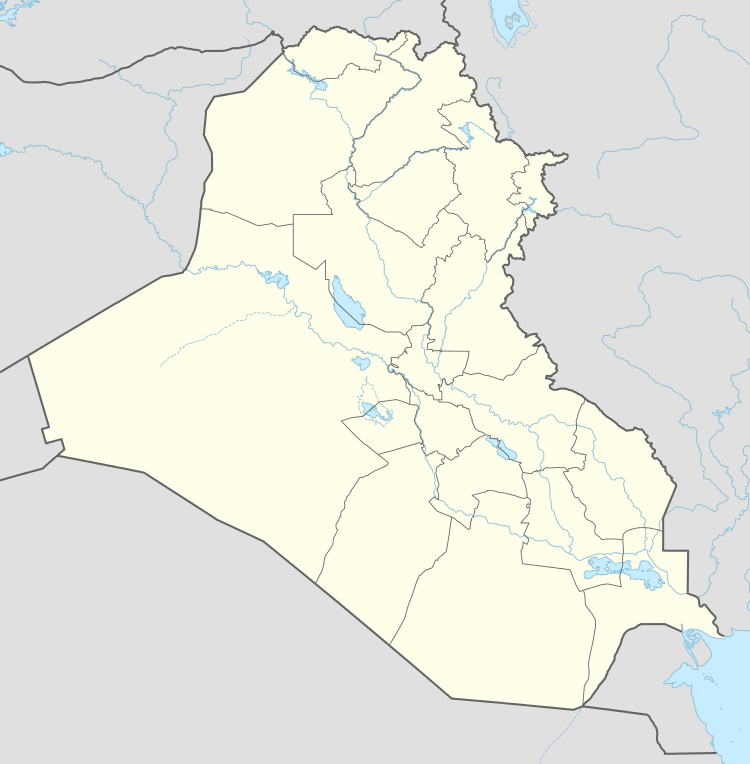Anbar (town)
| Anbar الأنبار | |
|---|---|
 Anbar Anbar's location inside Iraq | |
| Coordinates: 33°25′11″N 43°18′45″E / 33.41972°N 43.31250°E | |
| Country | Iraq |
| Governorate | Al Anbar |
Anbar (Arabic: الأنبار) was a town in Iraq, at lat. 33 deg. 22' N., long. 43 deg. 49' E, on the east bank of the Euphrates, just south of the Nahr 'Isa, or Sakhlawieh canal, the northernmost of the canals connecting that river with the Tigris.
History
Anbar was originally called Pērōz-Šāpūr or Pērōz-Šābuhr (from Middle Persian: 𐭯𐭥𐭩𐭥𐭦𐭱𐭧𐭯𐭥𐭧𐭥𐭩, meaning "Victorious Shapur"; in Parthian: 𐭐𐭓𐭂𐭅𐭆𐭔𐭇𐭐𐭅𐭇𐭓 prgwzšhypwhr; in Aramaic: פירוז שבור), and became known as Perisapora or Pirisabora to the Greeks and Romans. The city was founded ca. 350 by the Sassanid Persian king Shapur II, and located in the Sassanid province of Asōristān. Perisapora was sacked and burned by Emperor Julian in April 363, during his invasion of the Sassanid Empire.[1] The town became a refuge for the Arab, Christian and Jewish colonies of that region.[2] According to medieval Arabic sources, most of the inhabitants of the town migrated north to find the city of Hdatta south of Mosul.[3]
Anbar was adjacent or identical to the Babylonian Jewish center of Nehardea (Aramaic: נהרדעא), and lies a short distance from the present-day town of Fallujah, formerly the Babylonian Jewish center of Pumbeditha (Aramaic: פומבדיתא).
The name of the town was then changed to Anbar (Middle Persian word for "granaries"). Abu al-Abbas as-Saffah, the founder of the Abbasid caliphate, made it his capital, and such it remained until the founding of Baghdad in 762. It continued to be a place of much importance throughout the Abbasid period.[2]
Ecclesiastical History
Anbar used to host an Assyrian community from the fifth century: the town was the seat of a bishopric of the Church of the East. The names of fourteen of its bishops of the period 486–1074 are known, three of whom became[4] Chaldean Patriarch of Babylon.
- Narses fl540
- Simeon fl553
- Salibazachi fl714
- Paul fl740
- Theodosius
- Johnfl885
- Enos 890
- Elias fl906-920
- Jaballaha fl 960
- Sebarjesus
- Elias II fl987
- Unanmed bishop fl1021
- Mundar fl1028
- Maris fl1075
- Zacharias fl1111
No longer a residential bishopric, having faded.
Titular see
Anbar is today listed by the Catholic Church as a titular see of the Chaldean Catholic Church,[5] established as titular bishopric in 1980.
It has had the following incumbents, generally of the lowest (episcopal) rank, with a single archiepiscopal (intermediate) exception, the first :
- Titular Archbishop Stéphane Katchou (1980.10.03 – 1981.11.10), as Coadjutor Archeparch of Bassorah of the Chaldeans (Iraq) (1980.10.03 – 1981.11.10); later succeeded as Archeparch (Archbishop) of Bassorah of the Chaldeans (1981.11.10 – 1983.11.29), finally Archbishop-Bishop of Zaku of the Chaldeans (Iraq) (1983.11.29 – death 1987.11.08)
- Titular Bishop Ibrahim Namo Ibrahim (1982.01.11 – 1985.08.03), as Apostolic Exarch of United States of America of the Chaldeans (USA) (1982.01.11 – 1985.08.03); later restyled and promoted first Eparch (Bishop) of Saint Thomas the Apostle of Detroit of the Chaldeans (USA, the same) (1985.08.03 – 2014.05.03)
- Titular Bishop Shlemon Warduni (2001.01.12 – ...), Bishop of Curia of the Chaldean Catholic Church
Today
It is now entirely deserted, occupied only by mounds of ruins, whose great number indicate the city's former importance.[2]
See also
References
- ↑ G. W. Bowersock, Julian the Apostate, (Harvard University Press, 1978), 112.
- 1 2 3 Peters 1911.
- ↑ Lewis, Bernard (1986). "Ḥadīt̲a". In Hertzfeld, E. Encyclopaedia of Islam. 3 (Second ed.). BRILL. p. 29. ISBN 9789004081185. Retrieved 12 October 2012.
- ↑ Michel Lequien, Oriens christianus in quatuor Patriarchatus digestus, Paris 1740, Vol. II, coll. 1171-1174
- ↑ Annuario Pontificio 2013 (Libreria Editrice Vaticana 2013 ISBN 978-88-209-9070-1), p. 832
Sources and External links
- Attribution
-
 This article incorporates text from a publication now in the public domain: Peters, John Punnett (1911). "Anbar". In Chisholm, Hugh. Encyclopædia Britannica (11th ed.). Cambridge University Press.
This article incorporates text from a publication now in the public domain: Peters, John Punnett (1911). "Anbar". In Chisholm, Hugh. Encyclopædia Britannica (11th ed.). Cambridge University Press.
Coordinates: 33°22′43″N 43°42′57″E / 33.37861°N 43.71583°E